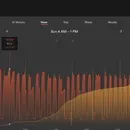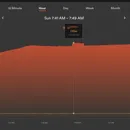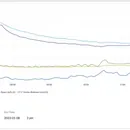Heat Pump Short Cycling
——–
Update 1: 1/25/2023: I added additional charts for different usage scenarios here: https://docs.google.com/presentation/d/e/2PACX-1vQL9H6vbpR-ihpkvnMdNcFkFrCX3kJbQqZnl_W9CuRQO1mtCEUYEqyNVzHiHzBEnjldnYbo-lnQMzcn/pub?start=false&loop=false&delayms=3000
——–
Original post: I have a 42k BTU Mitsubishi HyperHeat heat pump (MXZ5C42NAHZ2-U1) with 5 GL head units (6, 6, 9, 9, 12k BTU MSZ-GL units). Live in the Boston area. Installed it in April last year and my first winter season using it as the primary heating source (still have my legacy gas boiler as backup, which I haven’t had to use this season, woot!). House was built in 1929 and I had the exterior walls insulated last Spring, but it’s still quite leaky. House is around 1500 sqft. Attaching a few screenshots:
GBA Detail Library
A collection of one thousand construction details organized by climate and house part













Replies
You are short cycling severely. Being an older house your rooms are prolly smaller and have 1-3k btu load on design day. In addition your turn down on the outside unit is at best 13-15k. So for each head calling you get a lot of heat bleeding to other heads and hence the overshoot.
The only thing you can do is configure the heads to not run the fan when the thermostat is not calling for heat and install wired remotes some distance from the heads. This will reduce the cycling but your config will always short cycle a bit… or a lot.
Thanks for sharing your thoughts, @greenright! It sounds like MHK2 would indeed mask this problem.
In terms of reducing the short cycling, as far as I can tell, 6k BTU is the smallest GL head unit that Mitsubishi makes. Is it technically feasible to replace all my units with 6ks and swap out the outdoor unit to a 30k BTU system? I'm assuming my HVAC company won't like this idea, although they are a Diamond contractor, so maybe I could escalate to Mitsubishi and see what they say (last time I chatted with Mitsubishi customer support, they told me they only talk to contractors instead of homeowners).
Also, out of curiosity, is it possible to tell how much energy I'm wasting in my current setup due to this short cycling? Is it ballpark 10-20% or a lot more?
The minimum on that unit is a staggering 24k btu/hr at 47 degrees. That is crazy oversized for a 1500 sq ft house in Boston that spends a huge chunk of time in the 30's and 40's.
https://ashp.neep.org/#!/product/31974/7/25000///0
On the 1st power graph the unit looks like it is just cycling on the 6 minute minimum compressor runtime and 3 minute off time. It's not modulating at all and your probably getting a cop of 1.6-2 out of it. It's also drawing some serious power as it looks to ramp up to around 3kw before cycling off.
Its oversized and changing thermostats is not going to do anything about the short cycling. I would see if you could maybe split the units up into 2 smaller outdoor condensers like 2 18k outdoor units.
Hi bfw577! Thank you for sharing your thoughts, super helpful!
I'll share this power chart along with some additional usage scenarios I've been documenting the past couple of days (https://docs.google.com/presentation/d/e/2PACX-1vQL9H6vbpR-ihpkvnMdNcFkFrCX3kJbQqZnl_W9CuRQO1mtCEUYEqyNVzHiHzBEnjldnYbo-lnQMzcn/pub?start=false&loop=false&delayms=3000) with my installer who is coming in a couple of weeks and see what they say (other than them saying that MHK2 will solve everything). I've only had this system for about 9 months now so hopefully they'll be amenable to modifying/downsizing the equipment for a nominal fee (although they should give me a refund since I assume smaller units are cheaper than the larger units I have).
It looks like on one of your charts you are only running 1 single 6k head off that outdoor unit. Its around 47 in Boston right now, so if you were to turn on that single 6k head unit your compressor has to ramp up to its 24k btu minimum every time it starts. That means 18k btu of capacity is being wasted by just pumping that to all the other units even if their off. You basically need to have 24k worth of head units turned on just to hit the minimum capacity. And then those units are going to be blasting at like 100 percent which is going to be way oversized with heads in small rooms. Your heat load is most likely nowhere even close to that in the 40's so your unit is going to always cycle even at its minimum capacity.
This is also contributing to it. Those are some low setpoint's so in milder weather your heating load is going to be insanely low. Have your tried running more heads with higher setpoints to try and use up all of that minimum capacity?
"It’s a bit odd that some rooms overshot the 50F set point (Master bedroom and Kid’s bedroom were both around 62F), so don’t know if that’s somehow contributing to this, but seems odd."
"capacity is being wasted by just pumping that to all the other units even if their off"
<-- by off, do you mean those head units powered off or do you mean them being satisfied and just running the fan?
I tried the following test today: bumped up the setpoint to 62F and had 27k worth of head units turned on. It looks like the heat pump ran without short cycling for a solid 4 hours, and then started short cycling. I don't know for certain why, but looks like around 2:50pm, possibly because all head units were satisfied by that point.
Attaching pictures below.
Deleted
Mitsubishi (and all other multi split makers) know this is a problem. Mitsubishi even has an app note about it Application Note 1036:
https://mylinkdrive.com/USA/App_Notes
I would run through the numbers in the link bellow from a previous winter where you were using your fuel burner to see how oversized the system is and go from there. A call to Mitsubishi can help to move things along to get the right equipment in place.
https://www.greenbuildingadvisor.com/article/replacing-a-furnace-or-boiler
@Akos, thanks for sharing those links! I was reading App Note 1036 and wow, it felt like they wrote it for me. Glad to know that I'm not the first one to encounter this issue.
I'll call Mitsubishi again on Monday and see what they say in terms of getting the right equipment. This system was quite a large investment for me and I'm hoping I don't have to spend more $$$ to fix this.
I copied and pasted the link and trailing text, but still get "502 - Web server received an invalid response while acting as a gateway or proxy server." I even tried to change the direction of the slash between the linked and plain text portion.
I've got a similar issue, and no help at all with two different Mitsu Diamond contractors (as far as I can tell, that program is mostly marketing) so would REALLY like to see the app note about this..
Click on:
https://mylinkdrive.com/USA/App_Notes
From there you'll find the proper link to the app note.
Attaching a copy of the PDF for your reference.
mylinkdrive.com has been down all day for me today.
Thank you!!
The other thing you can do with oversized multi splits is run deep setbacks. Hopefully those rooms heat demands are on some kind of schedule so you can set them back aggressively. This will reduce short cycling. For example raise temp to 72 in the eve and drop it to 62 during the day. Recovering will take time and reduce your cycling. Run fans in the lowest speed and get remote wall mounted thermostats.
I know that folks are told to keep steady temps with heat pumps, but if you have the extra capacity- use it to your advantage.
Also if you have bad air quality, crack a window open to increase heat demand and make the pumps run longer. With some experimenting you can get a pretty good balance between efficiency and comfort. Also some indoor units have provisions for fresh air intake so you can reduce their capacity that way.
Lastly, your outdoor unit should have a power cut/ limit settings where you can limit the output of the outdoor to 80/60/40% of rating. This might be worth exploring - reducing capacity will result in longer run times.
Good luck
"your outdoor unit should have a power cut/ limit settings where you can limit the output of the outdoor to 80/60/40% of rating."3
I can't say I've ever heard of this. How does one go about that?
Thanks! Definitely going to try 1 or 2 MHK2s to see how they work in this system. My hunch is that they will fix the overheating/overcooling issue, but my system would still short cycle given how oversized it is.
Limiting outdoor capacity is definitely worth pursuing. Regarding that, I can't find anything listed in the submittal: http://www.mylinkdrive.com/viewPdf?srcUrl=http://s3.amazonaws.com/enter.mehvac.com/DAMRoot/Original/10006\M_Submittal_MXZ-5C42NAHZ.pdf. On page 3, I see "Total system wide capacity" as 12 to 54.6 kBTU/h. Is that the same thing? Does that also change the minimum BTUs of heat this would produce?
I chatted with Rochelle from MitsubishComfort.com online and she said that this wasn't an option for my unit. She said I'd need to replace it instead.
Deleted
An update on this issue: My installer installed MHK2s for each head unit (5 total, and free of cost) and also cut the jumper on the smaller/bedroom head units (3) and so far, I'm seeing about 30% reduction in my energy consumption, significant reduction in short cycling and way better temperature regulation and comfort in all rooms.
Thank you to everyone for sharing their experience and helping me navigate this issue!
Screenshots below.
This thread has been really helpful! What’s the purpose of the “jumper”, and what did cutting it do for your system?
By default Mitsubishi indoor units have the fan running at a low speed 24/7 even where there is no heat/cooling call. Cutting the jumper allows the fan to turn off completely.
+1 to what @aunsafe2015 said.
See AppNote 3048, option 8. MHK2 doesn't support the ability to turn off the fan for MSZ head units (but other units are supported), so cutting the jumper was necessary.
http://enter.mehvac.com.s3.amazonaws.com/DAMRoot/Original/10006/Application%20Note%203048%20ME%20-%20How%20to%20turn%20off%20indoor%20unit%20fan%20when%20set%20point%20is%20met.pdf
Gotcha--thanks! My initial impression was that the MHK2 alone could accomplish that (fans off). Didn't realize there was more to it.
Hi - just trying to understand your charts. Is the third one saying that over the course of 53 hours, your entire Mitsu HVAC system used only 1.506 kw? And this is in Boston's heating season?
Sorry, just to make sure I'm looking at the same chart as you, which one?
Thanks for sharing the update. Glad to hear that you've seen a solid improvement!
Also, that was generous of the installer to give you 5x MHK2s for free. That's like... $1500 worth of thermostats.
On the other hand, he designed and installed a system that didn't work, he should take responsibility for it.
There are a couple of solutions for overheating which you could try. They are easy and inexpensive and I find that they work. My experience with this problem is that it happens in the bedrooms when outside temps are mild and heat demands are low. I created a spring/fall schedule in my Flair Puck which sets back the temperature on the entire house at night during the spring and fall. This helps to prevent overheating in the bedrooms. Alternatively, you can turn off the unit in the other rooms at night (not the bedrooms) when it is really mild outside. Then, in the morning, the other rooms will recover quickly when you turn them back on. I find that the recovery in mild weather is really quick for my living room. I don't think the MHK-2 is a good solution, and it is really spendy. Don't cut any fan jumpers. My experience is that creates more problems than it solves.
See comment #19 for additional details, but the combination of MHK2s for all units + cutting jumper for the 3 smaller bedroom units have worked great for me. It's been 3 weeks since this change and I'm happy with the result so far.
shrayd, are you still happy with your solution? I'm in the same boat and before I call in the contractor, I'd love to know how things are working for you this winter and if the changes had any negative impacts on performance this summer.